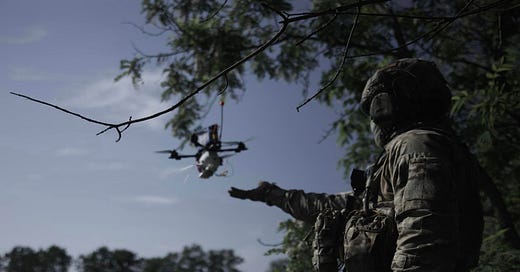Ukraine And Russia Both Build Huge Numbers of Explosive Drones. So Why Do Ukrainian Drone Strikes Outnumber Russian Strikes Six to One?
The Kremlin build drones, but can't distribute them
On paper, Russia and Ukraine both produce at least 100,000—and potentially many more—new first-person-view drones every month. So why do verified Ukrainian FPV strikes outnumber verified Russian strikes at least three to one, if not six to one?
One Russian blogger—simultaneously translated by Estonian analyst War Translated and Samuel Bendett, a drone expert with the Virginia-based think tank CNA—has theories.
In Ukraine, FPV drones come from two major sources: centralized domestic or foreign production paid for with government funds as well as the collective effort of many small Ukrainian workshops that often get their funding from private and non-profit donors.
In Russia, by contrast, the government has monopolized FPV drone production. And that both invites corruption and fraud and slows innovation. “In Russia, a lot of promising projects have stalled either because of bureaucracy or due to lack of funding,” the blogger noted. “We need to invest not only in state corporations for state defense orders, but also in promising do-it-yourself garage workers.”
Moreover, the Ukrainian FPV industry is more efficient on the distribution end. The Ukrainian defense ministry distributes drones based on its own assessment of units’ needs. But Ukrainian brigades also can solicit private funding and order drones on their own from small workshops. The diffuse demand signals help to ensure the right drones go to the right places in the right quantities at the right time.
By all accounts, Russian FPV distribution is—comparatively—hopelessly broken. “Supplies of FPVs and quadcopters to the front is uneven,” the blogger moaned. “[As] there is no centralized military distribution system, some units get everything while others get practically nothing—and much of such drone procurement still depends on unit commanders establishing a pipeline.”
The main lesson should be that centralized production of a vital weapon is risky if there isn’t also a corresponding centralized distribution process. The Kremlin is keen to oversee FPV production, but is less keen to oversee distribution.
It’s possible that the political system rewards officials who meet FPV production quotas, but is less responsive to the unglamorous work of shipping completed drones.
Bendett for one anticipated reforms. “Now that the Russian government is tasking the newly appointed defense minster Andrei Belousov to ‘open up’ the [ministry of defense] to greater cooperation with existing volunteer/startup projects, many Russian volunteers are also anticipating better acquisition/procurement pipelines of their FPVs,” he wrote.
But distribution reforms won’t solve a more fundamental problem—that the quality of Russian FPV builds generally is much lower than the quality of Ukrainian builds.
According to the Bendett, Russian testers have pointed out “significant technical issues, like FPVs not able to take to the air when out of the box on the front lines.”
Read more:
Remember When Someone Tried to Assassinate the Venezuelan President Using Explosive Drones?
This story originally appeared in Vice. A failed attack by explosives-laden drones on Venezuelan president Nicolas Maduro in August 2018 could be a harbinger of a new era. Cheap, easy-to-use, remotely-piloted aerial vehicles aren’t just toys, anymore. They’re potential tools of assassination.






